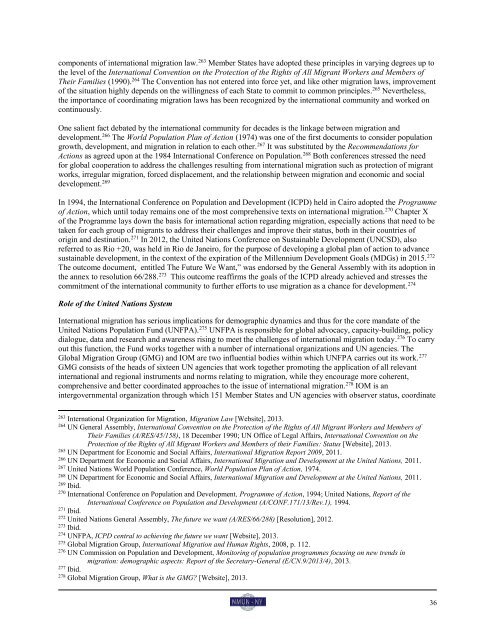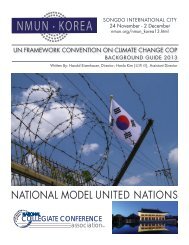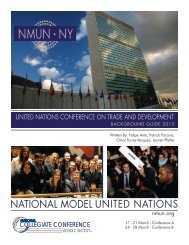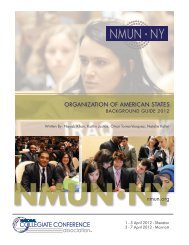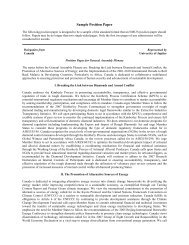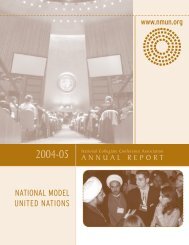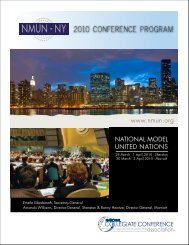UNFPA Background Guide - National Model United Nations
UNFPA Background Guide - National Model United Nations
UNFPA Background Guide - National Model United Nations
You also want an ePaper? Increase the reach of your titles
YUMPU automatically turns print PDFs into web optimized ePapers that Google loves.
components of international migration law. 263 Member States have adopted these principles in varying degrees up to<br />
the level of the International Convention on the Protection of the Rights of All Migrant Workers and Members of<br />
Their Families (1990). 264 The Convention has not entered into force yet, and like other migration laws, improvement<br />
of the situation highly depends on the willingness of each State to commit to common principles. 265 Nevertheless,<br />
the importance of coordinating migration laws has been recognized by the international community and worked on<br />
continuously.<br />
One salient fact debated by the international community for decades is the linkage between migration and<br />
development. 266 The World Population Plan of Action (1974) was one of the first documents to consider population<br />
growth, development, and migration in relation to each other. 267 It was substituted by the Recommendations for<br />
Actions as agreed upon at the 1984 International Conference on Population. 268 Both conferences stressed the need<br />
for global cooperation to address the challenges resulting from international migration such as protection of migrant<br />
works, irregular migration, forced displacement, and the relationship between migration and economic and social<br />
development. 269<br />
In 1994, the International Conference on Population and Development (ICPD) held in Cairo adopted the Programme<br />
of Action, which until today remains one of the most comprehensive texts on international migration. 270 Chapter X<br />
of the Programme lays down the basis for international action regarding migration, especially actions that need to be<br />
taken for each group of migrants to address their challenges and improve their status, both in their countries of<br />
origin and destination. 271 In 2012, the <strong>United</strong> <strong>Nations</strong> Conference on Sustainable Development (UNCSD), also<br />
referred to as Rio +20, was held in Rio de Janeiro, for the purpose of developing a global plan of action to advance<br />
sustainable development, in the context of the expiration of the Millennium Development Goals (MDGs) in 2015. 272<br />
The outcome document, entitled The Future We Want,” was endorsed by the General Assembly with its adoption in<br />
the annex to resolution 66/288. 273 This outcome reaffirms the goals of the ICPD already achieved and stresses the<br />
commitment of the international community to further efforts to use migration as a chance for development. 274<br />
Role of the <strong>United</strong> <strong>Nations</strong> System<br />
International migration has serious implications for demographic dynamics and thus for the core mandate of the<br />
<strong>United</strong> <strong>Nations</strong> Population Fund (<strong>UNFPA</strong>). 275 <strong>UNFPA</strong> is responsible for global advocacy, capacity-building, policy<br />
dialogue, data and research and awareness rising to meet the challenges of international migration today. 276 To carry<br />
out this function, the Fund works together with a number of international organizations and UN agencies. The<br />
Global Migration Group (GMG) and IOM are two influential bodies within which <strong>UNFPA</strong> carries out its work. 277<br />
GMG consists of the heads of sixteen UN agencies that work together promoting the application of all relevant<br />
international and regional instruments and norms relating to migration, while they encourage more coherent,<br />
comprehensive and better coordinated approaches to the issue of international migration. 278 IOM is an<br />
intergovernmental organization through which 151 Member States and UN agencies with observer status, coordinate<br />
263<br />
International Organization for Migration, Migration Law [Website], 2013.<br />
264<br />
UN General Assembly, International Convention on the Protection of the Rights of All Migrant Workers and Members of<br />
Their Families (A/RES/45/158), 18 December 1990; UN Office of Legal Affairs, International Convention on the<br />
Protection of the Rights of All Migrant Workers and Members of their Families: Status [Website], 2013.<br />
265<br />
UN Department for Economic and Social Affairs, International Migration Report 2009, 2011.<br />
266<br />
UN Department for Economic and Social Affairs, International Migration and Development at the <strong>United</strong> <strong>Nations</strong>, 2011.<br />
267<br />
<strong>United</strong> <strong>Nations</strong> World Population Conference, World Population Plan of Action, 1974.<br />
268<br />
UN Department for Economic and Social Affairs, International Migration and Development at the <strong>United</strong> <strong>Nations</strong>, 2011.<br />
269<br />
Ibid.<br />
270<br />
International Conference on Population and Development, Programme of Action, 1994; <strong>United</strong> <strong>Nations</strong>, Report of the<br />
International Conference on Population and Development (A/CONF.171/13/Rev.1), 1994.<br />
271<br />
Ibid.<br />
272<br />
<strong>United</strong> <strong>Nations</strong> General Assembly, The future we want (A/RES/66/288) [Resolution], 2012.<br />
273<br />
Ibid.<br />
274<br />
<strong>UNFPA</strong>, ICPD central to achieving the future we want [Website], 2013.<br />
275<br />
Global Migration Group, International Migration and Human Rights, 2008, p. 112.<br />
276<br />
UN Commission on Population and Development, Monitoring of population programmes focusing on new trends in<br />
migration: demographic aspects: Report of the Secretary-General (E/CN.9/2013/4), 2013.<br />
277<br />
Ibid.<br />
278<br />
Global Migration Group, What is the GMG? [Website], 2013.<br />
36


